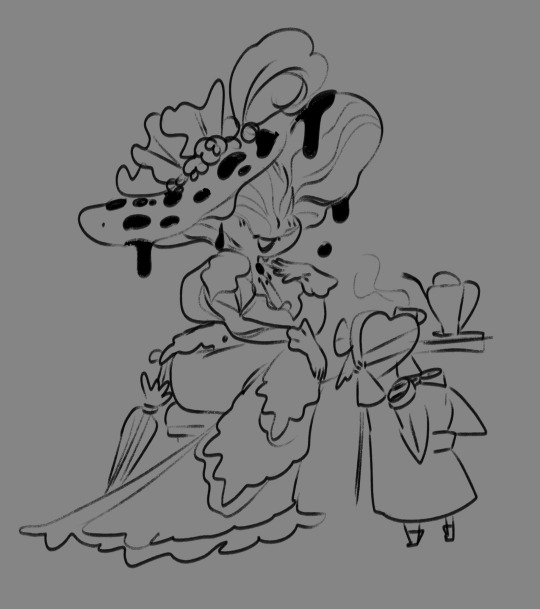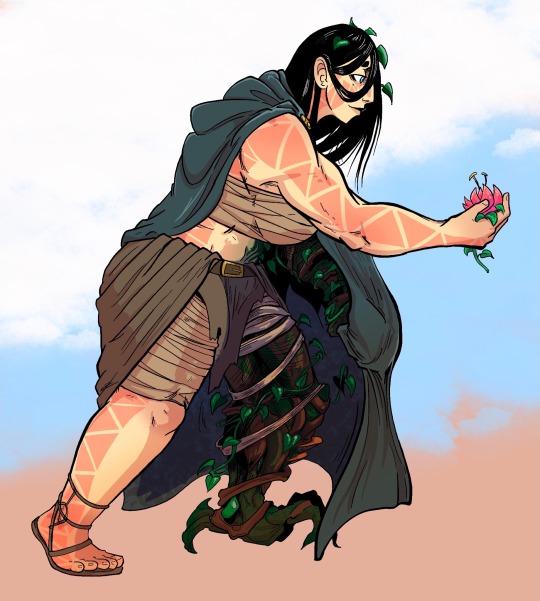#pf2
Text
the funniest thing about ttrpgs is that you can create a guy and say "his name is blorbo bleebus. he sucks severely. i hope that many misfortunes befall blorbo bleebus. he does not deserve to be happy." and at least one of your friends will immediately jump in to say "noooo... don't bully blorbo bleebus... i love blorbo bleebus..."
#my stuff#ttrpg#dnd#pf2#blorbo tag#edit:#i was not gonna use oc tags for every individual blorbo bleebus but i will because everyone tagging their own blorbo bleebus is so right#blanka my beloved#oc: kalef blakovel#oc: ksenia mitras#oc: cercil rebrum#oc: deltak libroh#oc: blumel narmor
18K notes
·
View notes
Text
Pathfinder has separate statblocks for the androsphinx and gynosphinx; that is, a sphinx with a man's head and chest, and a sphinx with a woman's head and chest, respectively. Notably, the gynosphinx's description states that the two are "different creature(s) entirely", which raises the question, how do all-male and all-female counterparts reproduce, if not with each other? The answer, to me, is clear.
2K notes
·
View notes
Text

can't believe my players won't let hasura kill them as a small treat to her 😔
#q#my art#dnd#dnd art#dnd character#dnd oc#dnd villain#dungeons and dragons#dungeons and drawings#pathfinder#pf2#pf2e#pf2e art#pf2e character#ocs: hasura#campaign: the land of horns & teeth#folly of helios
109 notes
·
View notes
Text




nicki minaj.
#black beauty#melanin#black girl aesthetic#black girl moodboard#black girl magic#nicki minaj#queen nicki#queen of rap#black tumblr#pink friday#pf2
120 notes
·
View notes
Text
lil doodle of my mushroom lady receiving hand crafted magical chocolates from a little goblin during a tea break.

Sometimes I think about how long Ghorans live and think about what if her wife's death was a product of a type of illness or plant disease which is what pushed her to pursue medicine.
maybe she has a employee who is a teeny tiny smarty Gobbo man and they are sweet on each other but of course it's kept professional.
I like they idea of her finding a 2nd love through trying to find alternative medicine.
35 notes
·
View notes
Text
In which I sound off for much too long about PF2 (and why I like it better than D&D 5E)
So, let me begin with a disclaimer here. I don’t hate 5E and I deeply despise edition warring. I like 5E, I enjoy playing it, and more, I think it’s an incredibly well-designed game, given what its design mandates were. This probably goes without saying but I wanted it on the record. While I will be comparing PF2 to D&D 5E in what follows and I’ve pretty much already spoiled the ending by the post title (that is, PF2 is going to come out ahead in these comparisons most of the time), I don’t want there to be any misunderstanding about my position or intention. My opinions do not constitute an attack on anybody. For that matter, things I might list as weaknesses in 5E or strengths of PF2 might be the exact opposite for other people, depending on what they want from their RPG experience.
As I said before, 5E is an exceedingly well-designed game that does an exceptional job of meeting its design goals. It just so happens that those design goals aren’t quite to my taste.
# A Brief History of the d20 RPG Universe #
I’m going to indulge myself in a little history for a second; some of it might even be relevant later, but for the most part, I just want to cover a little ground about how we got here. By the time the late ‘90s rolled around TSR and its flagship product, Dungeons and Dragons, were in trouble. D&D was well over two decades old by that point and showing its age. New ideas about what RPGs could and even should be had taken over the industry; TSR had finally lost its spot as best-selling RPG publisher to comparative upstart White Wolf and their World of Darkness games; the company even declared bankruptcy in 1997. Times were grim.
That, however, was when another comparative newcomer, Wizards of the Coast, popped up and bought TSR outright. Flush with MtG and Pokemon cash, they were excited to try to revitalize the D&D brand and began development on a new edition of D&D: third edition, releasing in August 2000.
Third edition was an almost literal revolution in D&D’s design, throwing a lot of “sacred cows” out and streamlining everywhere: getting rid of THAC0 and standardizing three kinds of base attack bonus progressions instead; cutting down to three, much more intuitive kinds of saving throws and standardizing them into two kinds of progression; integrating skills and feats into the core rules; creating the concept of prestige classes and expanding the core class selection. And of course, just making it so rolls were standardized as well, using a d20 for basically everything and making it so higher numbers are basically always better.
At the same time, WotC also developed the concept of the Open Gaming License (OGL), based on Open Source coding philosophies. The idea was that the core rules elements of the game could be offered with a free, open license to allow third-parties develop more content for the game than WotC would have the resources to do on their own. That would encourage more sales of the base game and other materials WotC released as well, creating a virtuous cycle of development and growing the industry for everyone.
Well, long story short (too late!), it worked like fucking gangbusters. 3E was explosive. It sold beyond anyone’s expectations, and the OGL fostered a massive cottage industry of third-party developers throwing out adventures, rules material, and even entire new game lines on the backs of the d20 system. A couple years later, 3.5 edition released, updating and streamlining further, and it was even more of a success than 3rd ed was.
At this point, we need turn for a moment to a small magazine publishing company called Paizo Publishing, staffed almost exclusively by former WotC writers and developers who had formed their own company to publish Dungeon and Dragon, the two officially-licensed monthly magazines (remember those?) for D&D. Dungeon focused on rules content, deep dives into new sourcebooks, etc., while Dragon was basically a monthly adventure drop. Both sold well and Paizo was a reasonably profitable company. Everything seemed to be going swimmingly.
Except. In 1999, WotC themselves were bought by board game heavyweight Hasbro, who wanted all that sweet, sweet Magic: the Gathering and Pokemon money. D&D was a tiny part of WotC at the time and the brand was moribund, so Hasbro’s execs hadn’t really cared if the weirdos in the RPG division wanted to mess around with Open Source licensing. It wasn’t like D&D was actually making money anyway… until it was. A lot of money. And suddenly Hasbro saw “their” money walking out the door to other publishers. So in 2007, WotC announced D&D 4th Ed, and unlike 3rd, it would not be released under an open license. Instead, it would be released under a much more restrictive, much more isolationist Gaming System License, which, among other things, prevented any licensee from publishing under the OGL and the GSL at the same time. They also canceled the licenses for Dungeon and Dragon, leaving Paizo Publishing without anything to, well, publish.
At first, Paizo opted to just pivot to adventure publishing under the OGL. Dungeon Magazine had found great success with a series of adventures over several issues that took PCs from 1st all the way to 20th level, something they were calling “Adventure Paths,” so Paizo said, “Well, we can just start publishing those! We’re good at it, the market’s there, it will be great!” And then, roughly four months after Paizo debuted its “Pathfinder Adventure Paths” line, WotC announced 4th Ed and the switch to the GSL. Paizo suddenly had a problem.
4th Ed wasn’t as big a change from 3rd Ed as 3rd Ed had been from AD&D, but it was still a major change, and a lot of 3rd Ed fans were decidedly unimpressed. Paizo’s own developers weren’t too keen on it either. So they made a fateful decision: they were going to use the OGL to essentially rewrite and update D&D 3.5 into an RPG line they owned: the Pathfinder Roleplaying Game. It was unprecedented. It was a huge freaking gamble. And it paid off more than anybody ever expected. Within two years Paizo was the second-largest RPG publisher in the industry, only behind WotC itself, and for one quarter late in 4E’s life, even managed to outsell D&D, however briefly. Ten years of gangbuster sales and rules releases followed, including 6 different monster books and something over 30 base classes when it was all said and done. It was good stuff and I played it loyally the whole time.
Eventually, though, time moves on and things have to change. The first thing that changed was 4E was replaced by D&D 5E in 2014, which was deliberately designed to walk back many of the changes in 4E that were so poorly received, keep a few of the better ones that weren’t, and in general make the game much more accessible to new players. It was a phenomenal success, buoyed by a resurgence of D&D in pop culture generally (Stranger Things and Critical Role both having large parts to play), and its dominance in the RPG arena hasn’t been meaningfully challenged since. It also returned to the use of the OGL, and a second boom of third-party publishers appeared and thrived for most of a decade.
The second thing was that PF1 was, itself, showing its age. RPGs have a pretty typical life cycle of editions and Pathfinder was reaching the end of one. It wasn’t much of a surprise, then, when, in 2018, Paizo announced Pathfinder 2nd Ed, which released in 2019 and will serve as the focus of the remainder of this post (yes, it’s taken me 1300 words to actually start doing the thing the post is supposed to be about, sue me).
There’s a coda to all of this in the form of the OGL debacle but I don’t intend to rehash any of it here - it was just like six months ago, come on - beyond what it specifically means for the future of PF2. That will come back up at the very end.
# Pathfinder 2E Basics #
So what, exactly, makes PF2 different from what has come before? There are, in my opinion, four fundamental answers to that question.
First: Unified math and proficiency progression. This piece is likely the part most familiar to 5E players, because 5E proficiency and PF2 proficiency both serve the same purpose, which is to tighten up the math of the game and make it so broken accumulations of bonuses aren’t really a thing. In contrast to 5E’s very limited proficiency, though, which just runs from +2 to +6 over the entire 20 levels of the game, Pathfinder’s scales from +0 to +28. Proficiency isn’t a binary yes/no, the way it is in 5E. PF2’s proficiency comes in five varieties: Untrained, Trained, Expert, Master, and Legendary. Your proficiency bonus is either +0 (Untrained) or your level + 2(Trained), +4 (Expert), +6 (Master) or +8 (Legendary). So if you were level five and Expert at something, your proficiency bonus would be level (5) plus Expert bonus (4) = +9.
Proficiency applies to everything in PF2, really - even more than 5E, if you can believe it, because it also goes into your Armor Class calculation. You can be Untrained, Trained, Expert, Master, or Legendary in various types of armor (or unarmored defense, especially relevant for many casters and monks), and your AC is calculated by your proficiency bonus + your Dex modifier + the armor’s own AC bonus, so AC scales just as attack rolls do. Once you get a handle on PF2 proficiency, you’ve grasped 95% of how any game statistic is calculated, including attacks, saves, skill checks, and AC.
Second: Three-Action Economy. Previous editions of D&D, including 5E, have used a “tiered” action system in combat, like 5E’s division between actions, moves, and bonus actions. PF2 has largely done away with that. At the start of your turn, you get three actions and a reaction, period (barring haste or slow or similar temporary effects). It takes one action to do one basic thing. “Attack” is an action. “Move your speed” is an action. “Ready a weapon” is an action. Searching for a hidden enemy is an action. Taking a guarded step is an action. Etc. The point being, you can do any of those as often as you have the actions for them. You can move three times, attack three times, move twice and attack once, whatever. Yes, this does mean you can attack three times in one turn at 1st level if you really want to (though there are reasons why you might not want to).
Some special abilities and most spells take more than one action to accomplish, so it’s not completely one-to-one, but it’s extremely easy to grasp and quite flexible at the same time. It’s probably my favorite of the innovations PF2 brought to the table.
Third: Deep Character Customization. So here’s where I am going to legitimately complain just a bit about 5E. I struggle with how little mechanical control I, as a player, have over how my character advances in 5E.
Consider an example. It’s common in a lot of 5E games to begin play at 3rd level, since you have a subclass by then, as well as a decent amount of hit points and access to 2nd level spells if you’re a caster. Let’s say you’re playing a fighter in a campaign that begins at 3rd level and is expected to run to 11th. That’s 8+ levels of play, a decent-length campaign by just about anyone’s standards. During that entire stretch of play, which would be a year or more depending on how often your group meets, your fighter will make exactly two (2) meaningful mechanical choices as part of their level-up process: the two points at 4th and 8th levels where you can boost a couple stats or get a feat. That’s it. Everything else is on rails, decided for you the moment you picked your subclass.
Contrast that with PF2. In that same level range, you would get to select: 4 class feats, 4 skill feats, two ancestry feats, two general feats, and four skill increases. At every level, a PF2 player gets to choose at least two things, in addition to whatever automatic bonuses they get from their class. These allow me to tailor my build quite tightly to whatever my idea for my character is and give me cool new things to play with every time I level up. This is true across character classes, casters and martials alike.
PF2 also handles multiclassing and the space that used to be occupied by prestige classes with its “pile o’ feats” approach. You can spend class feats from class A to get some features of class B, but it’s impossible for a multiclass build to just “steal” everything that makes a single class cool. A wizard/fighter will never be as good a fighter as a regular fighter is, and a fighter/wizard will never be the wizard’s match with magic.
Fourth: Four Degrees of Success. 5E applies its nat 20, nat 1, critical hits, etc. rules in a very haphazard fashion. PF2 standardizes this as well, in a way that makes your actual skill with whatever you’re doing matter for how well you do it. Any check in PF2 can produce one of four results: a critical success, a regular success, a regular failure, or a critical failure. In order to get a critical success on a roll, you have to exceed your target DC by 10 or more; in order to get a critical failure, you have to roll 10 or more less than the DC. Where do nat 20s and nat 1s come in? They respectively increase or decrease the level of success you rolled by one step. In practice, it works out a lot like you’re used to with a 5E game, but, for instance, if you have a +30 modifier and are rolling against a DC 18, rolling a nat 1 nets you a total of 31, exceeding the DC by more than 10 and earning you a critical success, which is then reduced to just a normal success by the fact of it being a nat 1. Conversely, rolling against a DC 40 with a +9 modifier can never succeed, because even a nat 20 only earns a 29, more than 10 below the DC and normally a crit failure, only increased to a regular failure by the nat 20.
Now, not every roll will make use of critical successes and critical failures. Attack rolls, for instance, don’t make any inherent distinction between failure and critical failure. (Though there are special abilities that do - try not to critically fail a melee attack against a swashbuckler. The results may be painful.) Skill rolls, however, often do, as do many spells with saving throws. Most spells that allow saves are only completely resisted if the target rolls a critical success. Even on a regular success, there is usually some effect, even on non-damaging rolls. That means that casters very rarely waste their turn on spells that get resisted and accomplish nothing at all. It also doubles the effect of any mechanical bonuses or penalties to a roll, because now there are two spots on a die per +1 or -1 that affect the outcome; a +1 might not only convert a failure to a success but might also convert a success to a crit success, or a crit fail to a regular fail.
# What About Everything Else? #
There is a lot more to it, of course. As a GM I find PF2 incredibly easy to run, even at the highest levels of game play, as compared to other d20 systems. The challenge level calculations work, meaning you can have a solo boss without having to resort to special boss monster rules to provide good challenges. I find the shift from “races” to “ancestries” much less problematic. PF2 has rules for how to handle non-combat time in the dungeon in ways that standardize common rules problems like “Well, you didn’t say you were looking for traps!” Everything using one proficiency calculation lets the game do weird things like having skill checks that target saves, or saves that target skill-based DCs. Inter-class balance, with some very specific exceptions, is beautifully tailored. Perception, always the uber-skill, isn’t a skill at all anymore: everyone is at least Trained in it, and every class reaches at least Expert in it by early double-digit levels. Opportunity Attacks (PF2 still uses the 3rd Ed “Attack of Opportunity” - but will soon be switching over to "Reactive Strike") isn’t an inherent ability of every character and monster, encouraging mobility during combats, and skill actions in combat can lower ACs, saves, attacks, and more, so there are more things to do for more kinds of characters. And so on.
Experiencing all of that is easiest just by playing the game, of course, but suffice it to say PF2 has a lot of QoL improvements for players and GMs alike in addition to the bigger, core-level mechanical differences.
# The OGL Thing #
Last thing, then. In the wake of the OGL shit in January, Paizo announced that it would no longer be releasing Pathfinder material under the OGL, opting instead to work with an intellectual property law firm to develop the Open RPG Creative (ORC) License that would do what the OGL could no longer be trusted to do: remain perpetually free and untouchable for anyone who wanted to publish under it. The ORC isn’t limited specifically to Paizo or to Pathfinder 2E or even to d20 games; any company can release any ruleset under it and allow third-party companies to develop and publish content for it.
Shifting away from the OGL, though, required making some changes to scrub out legacy material. A lot of the basic work was done when they shifted to 2E, but there are still a lot of concepts, terminologies, and potentially infringing ideas seeded throughout the system. These had to go.
Since this meant having to rewrite a lot of their core rules anyway, Paizo opted to not fight destiny and announced “Pathfinder 2nd Edition Remastered” in April. This is a kind of “2.25” edition, with a lot of small changes around the edges and a couple of larger ones to incorporate what they’ve learned since the game first launched four years ago. A couple classes are getting major updates, a ton of spells are either getting renamed or swapped out for non-OGL equivalents, and a couple big things: no more alignment and no more schools of magic.
The first book of the Remaster, Player Core 1, comes out in November, along with the GM Core. Next spring will see Monster Core and next summer will give us Player Core 2. That will complete the Remaster books; everything else is, according to Paizo, going to be compatible enough it won’t need but a few minor tweaks that can be handled via errata. So if you’re thinking about getting into PF2, I’d give serious thought to waiting until November at least, and maybe next summer if you want the whole Remastered package.
And that’s it. That’s my essay on PF2 and what I think makes it cool. The floor is open for questions and I am both very grateful and deeply apologetic to anyone who made it this far.
#RPGs#roleplaying games#d20#d20 history#pathfinder#pathfinder 2e#pf2#pf2e#dungeons and dragons#D&D#d&d 5e
115 notes
·
View notes
Text
Randall’s PF2 game requires me to bring a 4th character to fill some capability gaps, and somehow THIS IS THE MOST OPTIMAL BUILD

72 notes
·
View notes
Text


#Pink Friday 2#PF2#Black Femininity#Nicki Minaj#Barbz#Femalerap#Femaledaily#Femalerapper#Flawlessbeautyqueens#Nicki Minaj Fashion#Nicki Wallpaper#Rapper#Nicki Minaj Wallpaper#Pretty Woman#pocsource#Music#Barbzforminaj#onikatanyamarajpetty#Barbz4Life#Fashion#Emcee#White Outfit#Black Excellence#Black Beauty#Album#Photoshoot#dailymusicqueens#q#Update
48 notes
·
View notes
Text
We've Landed in #GAGCITY
I'm only 8 songs in and it's SO lit!
Here's some of my fav Gag City pix my friends send me since I'm not on twitter













36 notes
·
View notes
Text


Pink Friday 2 album cover 1/2:
Nicki wore a full look from Vetements spring/summer 2024 with Vetements heart necklaces.
Styling: Maher Jridi
Photography: Charlotte Rutherford
#nicki minaj#nicki minaj fashion#nicki minaj style#fashion#pf2#pink Friday 2#vetements#vetements ss24#Charlie Chops#Maher Jridi#Charlotte Rutherford
35 notes
·
View notes
Text
rip gojo he would’ve loved pink friday 2
23 notes
·
View notes
Text

Introducing Oasis, a shy but nurturing desert fleshwarp played by the vtuber Phoebe Bane! This was a really fun comm and it was really cool drawing one of my fave Pathfinder ancestries. Check 'em out!
#artists on tumblr#pathfinder#fleshwarp#dungeons and dragons#ttrpg#dnd#pf2#pathfinder 2ed#monstergirl
45 notes
·
View notes
Text

Patreon mythic spark commission for @kieranvalor!! I had a bunch of fun getting to design Helios for you!! <3
You can get your own trimonthly commission here!
148 notes
·
View notes
Text





TONIGHT WE LAND IN GAG CITYYYY!!!!
PINK FRIDAY 2
18 notes
·
View notes
Text

when ur friend is a huge 6'7 monster man and ur literally a 5'3 fish.
Ruvyn belongs to @doodles-and-teacups
pls go follow them they make pretty art & are cool♥
#my art#myart#pathart#path art#I am hyper fixating them so hard#dnd art#dnd character#pf2#pathfinder 2e#pathfinder art#pathfinder character#DOODLE#doodle#idk what to tag anymore#Nessie#Ruvyn
36 notes
·
View notes
Text


The collaborative map my new Pathfinder group made using The Quiet Year, vs. the redone version I made in Inkarnate!
I'm going to keep adjusting it and adding to it as we get into the game, but this was a lot of fun to do and create with my players!
#The quiet year#pathfinder#map#ttrpg#world maps#island#fantasy world#pathfinder 2e#inkarnate#cartography#desert#level 0#session 0#collaborative#second edition#pf2#collaborative storytelling#maps
10 notes
·
View notes